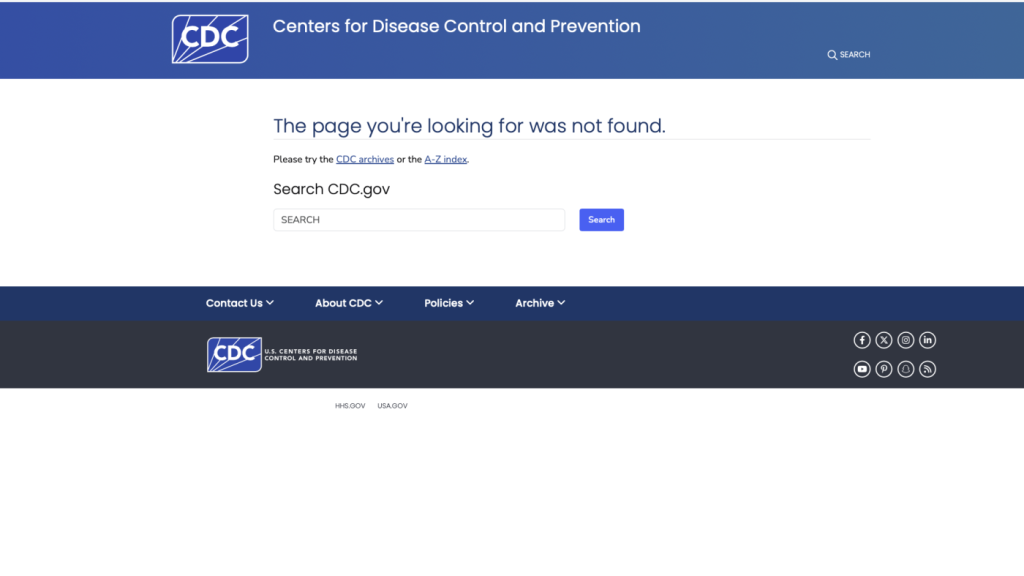
Webpages at the CDC and other health agencies went down on Friday.
Will Stone/NPR
hide caption
toggle caption
Will Stone/NPR
At the direction of the Trump administration, the federal Department of Health and Human Services and its agencies are purging its websites of information and data on a broad array of topics — from adolescent health to LGBTQ+ rights to HIV.
Several webpages from Centers for Disease Control and Prevention with references to LGBTQ+ health were no longer available. A page from the HHS Office for Civil Rights outlining the rights of LGBTQ+ people in health care settings was also gone as of Friday. The website of the National Institutes of Health’s Office for Sexual & Gender Minority Research Office disappeared. (Most of these pages could still be viewed through the Internet Archive.)
The changes at the CDC and NIH are examples of a broad push by the Trump administration on gender issues under an executive order titled “Defending Women from Gender Ideology Extremism and Restoring Biological Truth to the Federal Government.” That order directs agencies throughout the government to stop offering “gender identity” as a choice on government forms and to end funding of “gender ideology.”
Another order, signed by Trump, takes aim at “diversity, equity, and inclusion” across the federal government.
On Friday, however, many pages that did not seem related to “gender” or “diversity” had also been taken down, such as AtlasPlus, an interactive tool from CDC with surveillance data on HIV, viral hepatitis, STDs and TB. Also gone missing: a page with basic information about HIV testing. The CDC’s Social Vulnerability Index, a tool that assesses community resilience in the event of natural disaster was also taken down.
“The removal of HIV- and LGBTQ-related resources from the websites of the Centers for Disease Control and Prevention and other health agencies is deeply concerning and creates a dangerous gap in scientific information and data to monitor and respond to disease outbreaks,” the Infectious Diseases Society of America said in a statement. “Access to this information is crucial for infectious diseases and HIV health care professionals who care for people with HIV and members of the LGBTQ community and is critical to efforts to end the HIV epidemic.”
Data on adolescent health missing
One striking example of the vanishing information: The CDC pulled down the website that houses data collected by the nation’s largest monitoring program on health-related behaviors among high schoolers.
Pages related to the CDC’s Division of Adolescent and School Health, which administers the program, were also unavailable.
The Youth Risk Behavior Surveillance System tracks key metrics on nutrition, physical activity, tobacco and drug use, sexual behavior and other areas. The program was created 35 years ago and includes a national survey that researchers rely on to measure how behaviors influence health and design prevention measures.
“It’s the way the nation understands adolescent health,” says Stephen Russell, a sociologist at the University of Texas at Austin who studies adolescent health. “The disappearance of that data is stunning.”
The CDC did not respond to a request for comment on why the website is offline and whether the action is temporary.
However, a person with knowledge of the decision says agency staff had to take down the website — which includes data on many other dimensions of health — to be in compliance with President Trump’s “Defending Women” executive order.
The order says agencies “should take prompt actions to end all agency programs that use taxpayer money to promote or reflect gender ideology.” The order also says agencies must take “down all outward facing media (websites, social media accounts, etc.) that inculcate or promote gender ideology.” The deadline for action is 5 p.m. Friday.
Notably, the most recent survey asked students about “transgender identity” for the first time. The survey found that 3% of high school students self-identified as transgender and an additional 2% were “unsure.”
The published studies from previous years that contain overviews of the survey results still appear to be available in the archive for the CDC’s Morbidity and Mortality Weekly Report.
Researchers worry about future of teen survey
But the removal of the website and accompanying data has left researchers wondering what’s to become of the program itself.
“I’m giving a talk today where I’m going to cite some of the latest data on mental health,” said Bonnie Halpern-Felsher, a developmental psychologist at Stanford University, “But is this larger than just the website being down? Are they stopping the data collection? Are they stopping the reporting?”
The findings shape how schools and communities make decisions on evidence-based programs.
Russell says much of the data about the crisis in youth mental health — alarming increases in rates of adolescents reporting depression or self-harm behaviors like suicidality — come from this survey.
“So if these data disappear, we won’t have any information about what’s going on with our kids,” he says.








